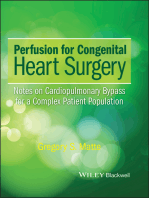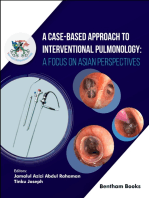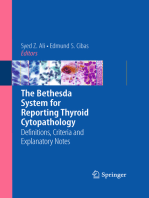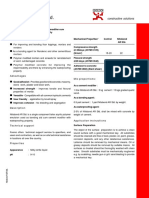Cardiac Risk Assessment
Cardiac Risk Assessment
Uploaded by
monir61Copyright:
Available Formats
Cardiac Risk Assessment
Cardiac Risk Assessment
Uploaded by
monir61Copyright
Available Formats
Share this document
Did you find this document useful?
Is this content inappropriate?
Copyright:
Available Formats
Cardiac Risk Assessment
Cardiac Risk Assessment
Uploaded by
monir61Copyright:
Available Formats
2005 Tan
Prepared by: Hanny Tan, M.D. Updated: June 14, 2006
Cardiac Risk Assessment
Key Points: 1. Patients with a high cardiac risk index have a markedly increased risk of perioperative cardiac complications. 2. Take into consideration whether the surgery is elective or emergent. 3. Consider delaying or canceling surgery if a high risk patient can not be medically optimized prior to surgery.
Assessing Patient Specific Risk
Due to the mortality and cost from post-operative myocardial infarction and cardiac complications, ways to reduce mortality have been studied. The first step is to identify intermediate and high risk patients. For years, patients have been risk stratified into low, intermediate, and high for developing perioperative cardiac complications. In 1977 Goldman, et al., developed the first preoperative cardiac risk index by looking at nine variables (preoperative third heart sound or jugular venous distention; myocardial infarction in the preceding six months; more than five premature ventricular contractions per minute documented at any time before operation; rhythm other than sinus or presence of premature atrial contractions on preoperative electrocardiogram; age over 70 years; intraperitoneal, intrathoracic or aortic operation; emergency operation; important valvular aortic stenosis; and poor general medical condition),which increased the risk of perioperative cardiac complications10. Since 1977, multiple cardiac risk indices have been developed, as well as guidelines for preoperative cardiac evaluation. In 1986, Detsky, et al., modified the original Goldman criteria (1977) adding unstable angina and pulmonary edema to the variables7. A point scale is assigned to each variable, which are then added to determine the patients class and cardiac risk.
Detskys Modified Cardiac Risk Index7 (Chart 1) Age > 70 years old Myocardial Infarction within 6 months Myocardial Infarction after 6 months Canadian Cardiovascular Society (CCS) of Angina (see table below) Class III Class IV Unstable angina within 6 months Alveolar pulmonary edema Within one week Ever Critical Aortic Stenosis Arrhythmia Rhythm other than sinus + PACs > PVCs Emergency Operation Poor General Medical Status Points 5 10 5 10 20 10 10 5 20 5 5 10 5
2005 Tan
Prepared by: Hanny Tan, M.D. Updated: June 14, 2006
Detskys Modified Cardiac Risk Index(cont)7 Class I II III Points 0-15 20-30 31+
(Chart 2) Cardiac Risk Low High
CCS Classification of Angina (Chart 3) 0 asymptomatic I Angina with strenuous exercise II Angina with moderate exertion III Angina with walking 1-2 blocks or climbing one flight of stairs or less at normal pace IV Inability to perform any activity without angina
In 1999, Lee, et al, revised Goldmans criteria for cardiac risk index and developed six independent predictors/variables which correlated with postoperative cardiac complications. Patients with more than 2 variables have a postoperative cardiac complication rate of ~10% and are considered to be high risk8. Lee Variables 1. high-risk type of surgery 2. ischemic heart disease (includes any of the following: history of myocardial infarction, history of a positive exercise test, current complaint of chest pain that is considered to be secondary to myocardial ischemia, use of nitrate therapy, or electrocardiography with pathologic Q waves) 3. congestive heart failure 4. history of cerebrovascular disease 5. preoperative treatment with insulin 6. preoperative serum creatinine >2.0 mg/dL
Lee Criteria-Revised Cardiac Risk Index8 (Chart 4) Number of Variables Risk of major postoperative cardiac complication 0 0.4% 1 0.9% 2 7.0% 3 11.0% High Risk
Separately, Eagle 1989 and Vanzetto 1996 looked at clinical predictors which could predict the probability of cardiac disease. These clinical predictors are considered low risk variables and are cumulative in predicting morbidity. The Eagle criteria (1989)looked at five clinical predictors of postoperative cardiac events: 1) Q waves on ECG, 2) angina, 3) ventricular ectopy, requiring therapy, 4) diabetes on therapy, and 5) age >70 years old. Patients without clinical predictors had only a 3% incidence of perioperative morbidity. Patients with three or more clinical risk factors had a morbidity rate of 50%. Neither group could be further risk stratified with noninvasive testing13. In 1996, Vanzetto G, et al. added a history of myocardial infarction, ST-segment abnormalities on ECG, hypertension with left ventricular hypertrophy, and history of congestive heart failure to Eagles clinical predictors. A patient with 2 variables is considered low to intermediate risk (3%-10%) and may benefit from further investigation9.
2005 Tan
Prepared by: Hanny Tan, M.D. Updated: June 14, 2006
Low Risk Indices/Variables (Chart 5) Eagle 198913 Q waves on ECG Angina Ventricular ectopy Diabetes Age >70 years old
Vanzetto 19969 Age >70 years Diabetes History of congestive heart failure Previous MI (at any time) Angina (any) Hypertension with severe LVH ST abnormalities on rest ECG Q waves
The American College of Cardiology and the American Heart Association (ACC/AHA) and the American College of Physicians (ACP) have published preoperative guidelines/algorithms. The ACC/AHA created guidelines for Perioperative Cardiovascular Evaluation for Noncardiac Sugery, last updated 200211. Their recommendations are based on a patients clinical predictors, patients functional status, and urgency of the surgery. The American College of Physicians (1997) uses Detskys modified cardiac index to determine whether a patient is Class I(low or intermediate risk) or II/ III(high risk). A Class I patient needs to be further stratified by calculating the number of low risk variables in the Modified Cardiac Risk Index (Eagle and Vanzetto criteria). This determines whether a patient remains a low risk (0-1 cardiac risk factors) or intermediate risk patient (>2 cardiac risk factors). Those intermediate risk patients undergoing vascular surgery are recommended to have further noninvasive testing. High risk patients need further intervention whether it is noninvasive or invasive testing, medical optimization, or modifying/canceling surgery. The main differences in the two guidelines are: ACC/AHA incorporates functional status, ACP DOES NOT ACC/AHA requires noninvasive testing for poor functional status ACP requires noninvasive testing for scheduled vascular surgery Please see the respective links for their algorithms/guidelines.
Assessing Surgical Related Risk
Cardiac Risk Stratification for Noncardiac Surgical Procedures11
High Cardiac Event Risk > 5% Intermediate Cardiac Event Risk < 5%
(Chart 6)
Emergent operations, particularly elderly Aortic and other major vascular surgery Peripheral vascular surgery Prolonged surgical procedures associated with large fluid shifts and/or blood loss Carotid endarterectomy surgery Head and neck surgery Intraperitoneal and intrathoracic surgery Orthopedic surgery Prostate surgery Endoscopic procedures Superficial procedure Cataract surgery Breast surgery
Low Cardiac Event Risk <1%
2005 Tan
Prepared by: Hanny Tan, M.D. Updated: June 14, 2006
REFERENCES:
1
Devereaux, P.J., et al. Are the recommendations to use perioperative -blocker therapy in patients undergoing noncardiac surgery based on reliable evidence? CMAJ 2004; 171(3): 245-247.
2 Poldermans, D., et al. The effect of bisoprolol on perioperative mortality and myocardial infarction in high-risk patients undergoing vascular surgery. NEJM 1999; 341(24):1789-94. 3 Mangano, D.T., et al. Effect of atenolol on the mortality and cardiovascular morbidity after noncardiac surgery. NEJM 1996; 335: 1713-20 4 Wallace, A., Effect of Clonidine on Cardiovascular Morbidity and Mortality after Noncardiac Sugery. Anesthesiology 2004; 101(2): 284-293. 5 Pasternack PF, Grossi EA, Baumann FG, Riles TS, Lamparello PJ, Giangola G, et al. Beta blockade to decrease silent myocardial ischemia during peripheral vascular surgery. Am J Surg. 1989;158:113-6. 6
Oliver MF, Goldman L, Julian DG, Holme I. Effect of mivazerol on perioperative cardiac complications during non-cardiac surgery in patients with coronary heart disease: the European Mivazerol Trial (EMIT). Anesthesiology. 1999;91:951-61.
Detsky AS, Abrams HB, McLaughlin JR, Drucker DJ, Sasson Z, Johnston N, et al. Predicting cardiac complications in patients undergoing noncardiac surgery. J Gen Intern Med. 1986;1:211-9 Lee TH, Marcantonio ER, Mangione CM, et al. Derivation and prospective validation of a simple index for prediction of cardiac risk of major noncardiac surgery. Circulation 1999; 100:1043-1049
9 Vanzetto G, Machecourt J, Blendea D, et al. Additive value of thallium single-photon emission computed tomography myocardial imaging for prediction of perioperative events in clinically selected high cardiac risk patients having abdominal aortic surgery. Am J Cardiol. 1996; 77:143-148 8
Goldman L, Caldera DL, Nussbaum SR, Southwick FS, Krogstad D, Murray B, et al. Multifactorial index of cardiac risk in noncardiac surgical procedures. N Engl J Med 1977;297:845-50
11
10
Eagle KA, Berger PB, Calkins H, Chaitman BR, Ewy GA, Fleischmann KE, Fleisher LA, Froehlich JB, Gusberg RJ, Leppo JA, Ryan T, Schlant RC, Winters WL Jr. ACC/AHA guideline update for perioperative cardiovascular evaluation for noncardiac surgery update: a report of the American College of Cardiology/American Heart Association Task Force on Practice Guidelines (Committee to Update the 1996 Guidelines on Perioperative Cardiovascular Evaluation for Noncardiac Surgery). 2002.
12
American College of Physicians. Guidelines for assessing and managing the perioperative risk from coronary artery disease associated with major noncardiac surgery. Ann Intern Med 1997;127: 309-12.
13 Eagle KA, Coley CM, Newell JB, Brewster DC, Darling RC, Strauss HW, et al. Combining clin-cal and thallium data optimizes preoperative assessment of cardiac ask before major vascular surgery. Ann Intern Med. 1989;110:859-66 14 Poldermans D, Bax JJ, Kertai MD, Krenning B, Westerhout CM, Schinkel AF, et al. Statins are associated with a reduced incidence of perioperative mortality in patients undergoing major noncardiac vascular surgery. Circulation. 2003;107:1848-51. 15 Kertai MD, Boersma E, Westerhout CM, van Domburg R, Klein J, Bax JJ, et al. Association between long-term statin use and mortality after successful abdominal aortic aneurysm surgery. Am J Med. 2004;116:96-103.
Lindenauer PK, Pekow P, Wang K, Gutierrez B, Benjamin EM. Lipid-lowering therapy and in-hospital mortality following major noncardiac surgery. JAMA. 2004;291:2092-9. Devereaux PJ, Beattie WS, et al. How strong is the evidence for the use of perioperative blockers in non-cardiac surgery? Systematic review and meta-analysis of randomized controlled trials. BMJ, doi:10.1136.
18 McFalls EO, Ward HB, Moritz TE, et al. Coronary-Artery Revascularization before Elective Major Vascular Surgery. NEJM 2004; 351(27): 2795-2804. 19 ONeil-Callahan K, Katsimaglis G, et al. Statins Decrease Perioperative Cardiac Complications in Patients Undergoing Noncardiac Vascular Surgery. JACC 2005; 45(3): 336-342. 17
16
You might also like
- Emperor Emmanuel-Dangerous Doomsday CultDocument148 pagesEmperor Emmanuel-Dangerous Doomsday CultFrancis LoboNo ratings yet
- MCQs in Cardiothoracic Surgery Mansoura Comprehensive Review with ExplanationsFrom EverandMCQs in Cardiothoracic Surgery Mansoura Comprehensive Review with ExplanationsNo ratings yet
- Arterial and Venous Access in the Cardiac Catheterization Lab: Arterial and Venous Access in the Cardiac Catheterization LabFrom EverandArterial and Venous Access in the Cardiac Catheterization Lab: Arterial and Venous Access in the Cardiac Catheterization LabMazen Abu-FadelNo ratings yet
- Live Better Electrically: A Heart Rhythm Doc's Humorous Guide to ArrhythmiasFrom EverandLive Better Electrically: A Heart Rhythm Doc's Humorous Guide to ArrhythmiasNo ratings yet
- A Simple Guide to Circulatory Shock, Diagnosis, Treatment and Related ConditionsFrom EverandA Simple Guide to Circulatory Shock, Diagnosis, Treatment and Related ConditionsNo ratings yet
- Handbook of Thoracic Malignancies and Esophageal Related CancerFrom EverandHandbook of Thoracic Malignancies and Esophageal Related CancerNo ratings yet
- Harmony in Disarray: Exploring Atrial Arrhythmias and Advancements in Cardiovascular HealthFrom EverandHarmony in Disarray: Exploring Atrial Arrhythmias and Advancements in Cardiovascular HealthNo ratings yet
- Degenerative Aortic Valve Disease, its Mechanism on Progression, its Effect on the Left Ventricle and the Postoperative ResultsFrom EverandDegenerative Aortic Valve Disease, its Mechanism on Progression, its Effect on the Left Ventricle and the Postoperative ResultsNo ratings yet
- Perfusion for Congenital Heart Surgery: Notes on Cardiopulmonary Bypass for a Complex Patient PopulationFrom EverandPerfusion for Congenital Heart Surgery: Notes on Cardiopulmonary Bypass for a Complex Patient PopulationRating: 5 out of 5 stars5/5 (2)
- How-to Manual for Pacemaker and ICD Devices: Procedures and ProgrammingFrom EverandHow-to Manual for Pacemaker and ICD Devices: Procedures and ProgrammingNo ratings yet
- A Case-Based Approach to Interventional Pulmonology: A Focus on Asian PerspectivesFrom EverandA Case-Based Approach to Interventional Pulmonology: A Focus on Asian PerspectivesJamalul Azizi Abdul RahamanNo ratings yet
- A Simple Guide to Hypovolemia, Diagnosis, Treatment and Related ConditionsFrom EverandA Simple Guide to Hypovolemia, Diagnosis, Treatment and Related ConditionsNo ratings yet
- Ebstein Anomaly, A Simple Guide To The Condition, Diagnosis, Treatment And Related ConditionsFrom EverandEbstein Anomaly, A Simple Guide To The Condition, Diagnosis, Treatment And Related ConditionsNo ratings yet
- The Bethesda System for Reporting Thyroid Cytopathology: Definitions, Criteria and Explanatory NotesFrom EverandThe Bethesda System for Reporting Thyroid Cytopathology: Definitions, Criteria and Explanatory NotesNo ratings yet
- Current Best Practice in Interventional CardiologyFrom EverandCurrent Best Practice in Interventional CardiologyBernhard MeierRating: 3 out of 5 stars3/5 (1)
- The Natural and Unnatural History of Congenital Heart DiseaseFrom EverandThe Natural and Unnatural History of Congenital Heart DiseaseNo ratings yet
- A Simple Guide to Abdominal Aortic Aneurysm, Diagnosis, Treatment and Related ConditionsFrom EverandA Simple Guide to Abdominal Aortic Aneurysm, Diagnosis, Treatment and Related ConditionsNo ratings yet
- Catheter Ablation of Cardiac Arrhythmias: Basic Concepts and Clinical ApplicationsFrom EverandCatheter Ablation of Cardiac Arrhythmias: Basic Concepts and Clinical ApplicationsDavid J. Wilber, M.D.No ratings yet
- Advanced Endovascular Therapy of Aortic DiseaseFrom EverandAdvanced Endovascular Therapy of Aortic DiseaseAlan B. LumsdenNo ratings yet
- Cardiac Pacing, Defibrillation and Resynchronization: A Clinical ApproachFrom EverandCardiac Pacing, Defibrillation and Resynchronization: A Clinical ApproachNo ratings yet
- Anesthesia for Congenital Heart DiseaseFrom EverandAnesthesia for Congenital Heart DiseaseStephen A. StayerNo ratings yet
- A Simple Guide to Capillary Leak Syndrome, Diagnosis, Treatment and Related ConditionsFrom EverandA Simple Guide to Capillary Leak Syndrome, Diagnosis, Treatment and Related ConditionsNo ratings yet
- Diagnostic Imaging of Infections and Inflammatory Diseases: A Multidiscplinary ApproachFrom EverandDiagnostic Imaging of Infections and Inflammatory Diseases: A Multidiscplinary ApproachNo ratings yet
- Clinical Cases in Right Heart FailureFrom EverandClinical Cases in Right Heart FailureLana TsaoNo ratings yet
- Cardiac Tamponade, A Simple Guide To The Condition, Diagnosis, Treatment And Related ConditionsFrom EverandCardiac Tamponade, A Simple Guide To The Condition, Diagnosis, Treatment And Related ConditionsNo ratings yet
- Angioplasty, (Stent Dilatation) A Simple Guide To The Condition, Diagnosis, Treatment And Related ConditionsFrom EverandAngioplasty, (Stent Dilatation) A Simple Guide To The Condition, Diagnosis, Treatment And Related ConditionsRating: 5 out of 5 stars5/5 (1)
- Cardiac MappingFrom EverandCardiac MappingMohammad ShenasaNo ratings yet
- Ethical Challenges of Organ Transplantation: Current Debates and International PerspectivesFrom EverandEthical Challenges of Organ Transplantation: Current Debates and International PerspectivesSolveig Lena HansenNo ratings yet
- Intubating the Critically Ill Patient: A Step-by-Step Guide for Success in the ED and ICUFrom EverandIntubating the Critically Ill Patient: A Step-by-Step Guide for Success in the ED and ICURachel GarvinNo ratings yet
- Cough: Causes, Mechanisms and TherapyFrom EverandCough: Causes, Mechanisms and TherapyKian Fan ChungNo ratings yet
- Cracking Chests: How Thoracic Surgery Got from Rocks to SticksFrom EverandCracking Chests: How Thoracic Surgery Got from Rocks to SticksNo ratings yet
- The Anatomical Foundations of Regional Anesthesia and Acute Pain MedicineFrom EverandThe Anatomical Foundations of Regional Anesthesia and Acute Pain MedicineNo ratings yet
- Fast Facts: Thrombotic Thrombocytopenic Purpura: Prompt Action Saves LivesFrom EverandFast Facts: Thrombotic Thrombocytopenic Purpura: Prompt Action Saves LivesNo ratings yet
- Manual of STEMI InterventionsFrom EverandManual of STEMI InterventionsSameer MehtaNo ratings yet
- Critical Care Medications: Vasopressors, Inotropes and Anti-Hypertensives Study Guide: Critical Care EssentialsFrom EverandCritical Care Medications: Vasopressors, Inotropes and Anti-Hypertensives Study Guide: Critical Care EssentialsNo ratings yet
- Problem-based Approach to Gastroenterology and HepatologyFrom EverandProblem-based Approach to Gastroenterology and HepatologyJohn N. PlevrisNo ratings yet
- Cardiac Risk Assessment - StatPearls - NCBI BookshelfDocument11 pagesCardiac Risk Assessment - StatPearls - NCBI Bookshelfcarlo_nonNo ratings yet
- Evaluation of Cardiac Risk Prior To Noncardiac Surgery - UpToDateDocument32 pagesEvaluation of Cardiac Risk Prior To Noncardiac Surgery - UpToDateJose Carbonell100% (1)
- Review Articles: Medical ProgressDocument10 pagesReview Articles: Medical ProgressMiko AkmarozaNo ratings yet
- 1998-01-07 Risk Factors in Cardiac Surgery PDFDocument7 pages1998-01-07 Risk Factors in Cardiac Surgery PDFHuplala HypocrateNo ratings yet
- Coronary ThrombosisDocument1 pageCoronary Thrombosismonir61No ratings yet
- Technique For Awake Fibre Optic IntubationDocument3 pagesTechnique For Awake Fibre Optic Intubationmonir61No ratings yet
- PALS 2010 OverviewDocument26 pagesPALS 2010 Overviewmonir61No ratings yet
- Calcium Homeostasis: Bone Blood Ca++ KidneyDocument12 pagesCalcium Homeostasis: Bone Blood Ca++ KidneyOmSilence2651No ratings yet
- 2016 CUSP A Framework For SuccessDocument31 pages2016 CUSP A Framework For Successmonir61No ratings yet
- Update On PDPHDocument18 pagesUpdate On PDPHmonir61No ratings yet
- Tonsillectomy and AdiniodectomyDocument0 pagesTonsillectomy and Adiniodectomymonir61No ratings yet
- Dom Strategic Plan 2012Document64 pagesDom Strategic Plan 2012monir61No ratings yet
- Admission Nursing AssessmentDocument20 pagesAdmission Nursing Assessmentmonir61No ratings yet
- Improving The Patient Experience Through Nursing and Midwifery KpisDocument35 pagesImproving The Patient Experience Through Nursing and Midwifery Kpismonir61No ratings yet
- HBI Herniated Disc GuideDocument12 pagesHBI Herniated Disc Guidemircea2000pNo ratings yet
- Brenda Creaney PresentationDocument21 pagesBrenda Creaney Presentationmonir61No ratings yet
- Management of Intravascular Catheter Related InfectionDocument19 pagesManagement of Intravascular Catheter Related Infectionmonir61No ratings yet
- LumbarlandDocument10 pagesLumbarlandmonir61No ratings yet
- Cystoscopy: A Guide For WomenDocument2 pagesCystoscopy: A Guide For Womenmonir61No ratings yet
- TandA 9912Document50 pagesTandA 9912Vinod RajNo ratings yet
- Hysterectomy: The American College of Obstetricians and GynecologistsDocument0 pagesHysterectomy: The American College of Obstetricians and Gynecologistsmonir61No ratings yet
- Organic MatterDocument23 pagesOrganic MatterMelikteNo ratings yet
- Nitobond AR Std.Document4 pagesNitobond AR Std.Dinesh Kumar PatelNo ratings yet
- C15 ADAC 01 of 2019R1 Guidance On RWY FrictionDocument10 pagesC15 ADAC 01 of 2019R1 Guidance On RWY FrictiondineshonlineNo ratings yet
- Final AccountsDocument10 pagesFinal AccountsKeeme TathegoNo ratings yet
- Manual Transicion j7 A j1000Document19 pagesManual Transicion j7 A j1000fleabassistNo ratings yet
- 3.1 Sequences and SeriesDocument15 pages3.1 Sequences and SeriesAMSYARUL MARLIANA BT KHAIRUL ANUAR STUDENTNo ratings yet
- Beira International School: Mid-Year ExaminationDocument7 pagesBeira International School: Mid-Year ExaminationnothandoNo ratings yet
- Quest Book Cbse 9 MathsDocument29 pagesQuest Book Cbse 9 MathsRekha SharmaNo ratings yet
- Value Chain Analysis in West Bengal and MPDocument65 pagesValue Chain Analysis in West Bengal and MPAkshatGiriNo ratings yet
- Comparative and Superlative AdjectivesDocument15 pagesComparative and Superlative AdjectivesLIZBETH ARROYO DAMIANNo ratings yet
- Final Report Maruti SuzukiDocument57 pagesFinal Report Maruti SuzukiSarva ShivaNo ratings yet
- GS-HG Kiln Shell Scanner, Technical ManualDocument15 pagesGS-HG Kiln Shell Scanner, Technical Manualvsrikala68No ratings yet
- Lesson Plan Template - Integrated Curriculum Unit: Lauren Moss Curriculum Content Areas: Physical ScienceDocument5 pagesLesson Plan Template - Integrated Curriculum Unit: Lauren Moss Curriculum Content Areas: Physical Scienceapi-531832766No ratings yet
- Resume (Nikhil Sharma)Document3 pagesResume (Nikhil Sharma)Jai SoniNo ratings yet
- 1 - Road Geometry July 2003 (Dmrb-Malta)Document199 pages1 - Road Geometry July 2003 (Dmrb-Malta)daminduffNo ratings yet
- Air India (Formerly Tata Airlines) : A Presentation by Jaideep BakreDocument10 pagesAir India (Formerly Tata Airlines) : A Presentation by Jaideep BakreArjun Jinumon PootharaNo ratings yet
- Automatic Computer Vision For Aquatic ResearchDocument156 pagesAutomatic Computer Vision For Aquatic ResearchVIGNESHNo ratings yet
- (Oxford Handbooks) Andrew C. Isenberg - The Oxford Handbook of Environmental History-Oxford University Press (2014)Document801 pages(Oxford Handbooks) Andrew C. Isenberg - The Oxford Handbook of Environmental History-Oxford University Press (2014)Trovador Morrison100% (1)
- Potential Adverse Effects of Long-Term Consumption of Fatty AcidsDocument11 pagesPotential Adverse Effects of Long-Term Consumption of Fatty Acidstaner_soysurenNo ratings yet
- 03 TOOLKIT Module3 PDFDocument68 pages03 TOOLKIT Module3 PDFmrccahmedNo ratings yet
- MasterTop P 617 PTADocument15 pagesMasterTop P 617 PTAMaha MuflehNo ratings yet
- ChristianityDocument4 pagesChristianitystevennaing44No ratings yet
- WiFi-Pineapple Ebook v22.03Document47 pagesWiFi-Pineapple Ebook v22.03RicardoNunesNo ratings yet
- Grundig Cuc 7350Document3 pagesGrundig Cuc 7350pepitito22100% (1)
- 1 ND: Transportation Engineering 3Document15 pages1 ND: Transportation Engineering 3Samkelo MdunaNo ratings yet
- Hao-Ran Lin, Bing-Yuan Cao, Yun-Zhang Liao (Auth.) - Fuzzy Sets Theory Preliminary - Can A Washing Machine Think - Springer International Publishing (2018)Document170 pagesHao-Ran Lin, Bing-Yuan Cao, Yun-Zhang Liao (Auth.) - Fuzzy Sets Theory Preliminary - Can A Washing Machine Think - Springer International Publishing (2018)gagah100% (2)
- Summary of Farm ExprienceDocument6 pagesSummary of Farm ExprienceshmekebeNo ratings yet
- Reliable, Secure and Resilient Logistics Networks: Lech BukowskiDocument281 pagesReliable, Secure and Resilient Logistics Networks: Lech BukowskimyosanaungNo ratings yet
- I. Objectives: Figure1. A Typical Bridge CircuitDocument6 pagesI. Objectives: Figure1. A Typical Bridge CircuitThảo Nguyễn PhươngNo ratings yet










































































































